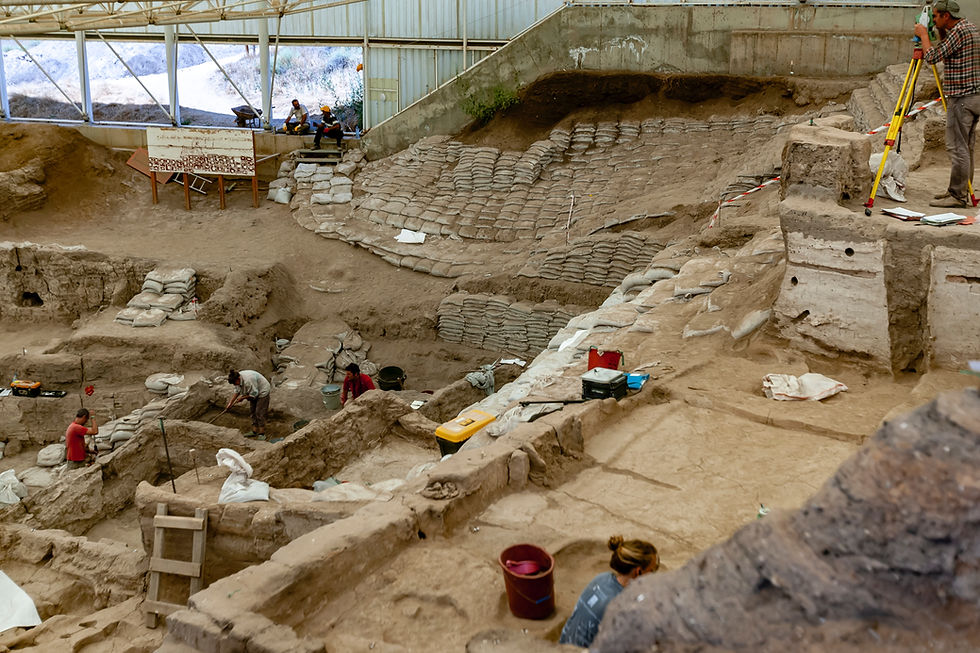After the Ice Age - Neolithic Builders
- Sylvia Rose

- Feb 27, 2024
- 5 min read
Updated: Mar 1, 2024
Neolithic building societies arise as the last Ice Age ends c. 10,000 BCE. The end of the ice age leads to warming climates and migrations of scattered groups. They occupy areas previously uninhabited as the Neolithic Revolution accelerates.
READ: Cult of the Fire God - Bronze Age Quest Adventure
See also:
The end of the Ice Age marks the pre-Holocene period (Age of Humans) which begins c. 9700. Giant short-faced bears and giant ground sloths go extinct as early humans migrate to new lands. In North America, horses also go extinct at this time.
READ: Cult of the Fire God - Bronze Age Quest Adventure
Other prehistoric animals, like the saiga antelope, get through to the modern era. Although endangered, this hardy antelope is making a comeback today from the brink of population wipeout. In Neolithic times it's an important prey animal.
See also:
In c. 10,000 - 8200 BCE in today's Cyprus, the arrival of Homo sapiens destroys the only known populations of dwarf elephants and pygmy hippos. Large piles of bones attest to the animals and their popularity as edibles.
Before Homo sapiens, Homo erectus spreads through Africa and non-Arctic Eurasia. The oldest known evidence of anatomically modern humans are fossils found at Jebel Irhoud, Morocco, dating to about 360,000 years ago.
See also:
Evidence of the ability to speak or create language appears c. 50,000 BCE. The oldest civilizations of Homo sapiens are progressive and communally structured. Early regions of human building and activity include:
China - Yellow River c. 10,600 BCE; Huang He River c. 10,000 BCE
Syria - Damascus c. 10,000 BCE
Jordan - Jericho c. 9600 BCE
Anatolia - Göbekli Tepe, megalithic site c. 9500 BCE
Danube Valley - c. 9500 BCE
Anatolia - Cilicia c. 8500 BCE
Cyprus - Aetokremnos c. 8,200 BCE
Anatolia - Çatalhöyük c. 7500 BCE
Indus Valley - c. 7000 BCE
Portugal - Almedndres Cromlech , megalithic site c. 6000 - 4000 BCE
Southeast Europe - Vinča culture , Danube c. 5500 BCE
Ireland - monumental tombs dating to 4500 BCE
Mesopotamia - Uruk c. 4000 BCE
Egypt - Faiyum (Crocodilopolis), middle Nile, c. 4000 BCE
England - Stonehenge, megalithic site c. 3000 BCE
See also:
The beginning of the Bronze Age predates the end of the Neolithic c. 2000. After 3300 BCE, Bronze Age civilizations and settlements develop and expand at sites throughout the world.
READ: Cult of the Fire God - Bronze Age Quest Adventure
Trade opportunities increase. Metals such as copper and bronze create better tools and weapons, though stone continues to be used. Buildings become palatial in scope. The Age of Kings begins. Me-baragesi is the first monarch, reigning in Mesopotamia c. 2700 BCE.
See also:
Back in 10,000 BCE the Neolithic Revolution, also known as the First Agricultural Revolution, marks the transition of many human cultures from hunter-gatherer to agriculture and settlement lifestyles. This leads to building and population growth.
In Neolithic times people travel in small tribal or clan groups. It's the era of the ubiquitous nomadic hunter-gatherer. The people follow routes of wild animals, fish the sea or inland waters and forage from the land.
See also:
The climate is about 4° warmer after the ice age, prompting migration northward as southern resources dry up. Droughts might be seasonal or longer, caused by yearly flood and dry cycles, river changing course or building of dams.
In the arid south, settlements appear near wadis, or seasonal water supply centers such as streams and temporary lakes. Ground water is also an important resource. A fig tree in the desert is a sign of groundwater within 6 ft (1,8 m) of the surface.
See also:
After the Ice Age, the people cultivate land, raise crops and domesticate animals. The dog is already domestic by c. 12,000 BCE, used for work, companionship or if necessary, food.
Sheep and goats are domesticated c. 8200 BCE as the Neolithic Revolution accelerates.
Not every Neolithic culture builds megaliths. A number of colossal structures are created later, such as the Easter Island stones (c. 1400 - 1600 CE).
See also:
These settled communities allow further domestication of livestock, animal husbandry and experimentation with crops, seeds and soil. Settlement sees an increase in skills such as weaving, medicine and metal work.
The Neolithic city Catalhoyuk supports a population of up to 8,000 individuals in the 8th millennium BCE. In a nearby prehistoric cave are skulls with horns (bucrania) are preserved in a sanctuary, attesting to an earlier or ongoing bull cult.
See also:
Built on coastal Mesopotamia in 4000 BCE, Uruk later becomes the first city to reach a population of 50,000. It's in the fertile crescent created in part by the waters and watersheds of the Tigris and Euphrates rivers originating in the Taurus Mountains.
In Egypt the construction of the first pyramid, that of Khufu, occurs c. 2600, an overlap of the end of the Neolithic and start of the Bronze Age. In the fertile crescent a trend of monumental architecture prevails in Mesopotamia, Anatolia, Assyria and Egypt.
See also:
Architecture in Mesoamerica echoes that of the step pyramids of Egypt an ocean away. There the first monumental building civilizations arise in c. 2000 BCE with the Gulf Coast cultures, Olmec and Monte Alto Cultures.
See also:












